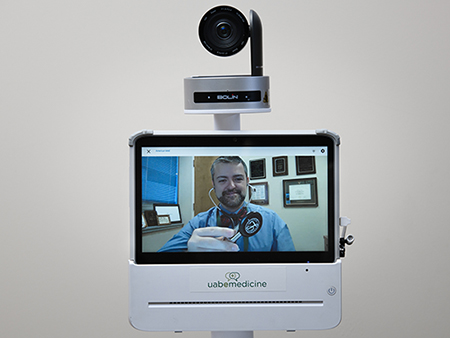By Holly Gainer
UAB News
As COVID-19 continues to spread in the United States, health care providers are turning to technology to help treat patients who may be infected and also prevent the spread of the illness. Plans to use telehealth technology to fight the spread of the virus are already in place at the University of Alabama at Birmingham.
According to Eric Wallace, M.D., the medical director of UAB eMedicine, UAB is considering using telehealth through three approaches to help care for patients both in Birmingham and around the state.
Keep patients at home
The first approach is to keep as many patients who do not have upper respiratory symptoms at home, especially those who have weakened immune systems. The most common COVID-19 symptoms are fever, runny nose, dry cough, shortness of breath, fatigue and body aches.
“We plan to use telehealth technology to see as many patients in their homes as possible, especially those who are most at risk, such as the elderly and immunosuppressed patients,” Wallace said. “For example, if you have a urinary tract infection, the last thing you should do is go to the doctor’s office and wait in a waiting room when you could have had your UTI treated from home.”
If you have any of the COVID-19 symptoms, you should call your health care provider first before going to the doctor’s office. If you do not have any of the symptoms, but need medical care, Wallace recommends calling your doctor or using UAB’s eMedicine online service. The service allows doctors to diagnose and treat patients for a variety of common conditions online. Furthermore, UAB’s eMedicine online service is now serving as a location to help screen patients with COVID-19 symptoms to determine whether referral for in-person testing is necessary.
Isolate patients and limit the amount of time spent with health care providers
Limiting the amount of time health care providers spend in a hospital room with an infected patient will help reduce the risk of spreading the virus.
Instead of being in the room to go over the patient’s medical history, the doctors or nurses could do this via video technology as opposed to lengthy in-person visits, which could take 30-45 minutes. In this case, patients will have a telehealth cart in their room to use to see and communicate with the doctor via video conferencing. Family members can also be video-conferenced in to see their loved ones.
“It is important to limit exposure to our providers to ensure they can remain healthy and continue to treat patients,” Wallace said. “One way to accomplish this is to limit the amount of physical face-to-face time between health care providers and patients.” Furthermore, there may be upcoming shortages of protective masks, and as such, using telehealth may be able to stretch the supply of protective gear during times of shortage.
UAB is in the process of training more physicians and nurses on how to use telehealth technology in order to treat patients when the need arises.
Expanding tele-critical care
UAB already provides critical care via telehealth to four hospitals around the state. However, if COVID-19 spreads in the state, additional providers will be needed to care for patients considered to be in critical care or in need of an ICU.
Wallace and his team are working to expand the number of sites in order to support hospital staff when necessary.
“If a large number of patients are infected, doctors will become infected too,” Wallace said. “If this happens, we have a plan in place to supplement health care providers while they are out of commission. We will be able to man critical care units remotely and provide support to hospitals that may be facing a staffing shortage.”
For more information about COVID-19, visit www.uab.edu/coronavirus.




